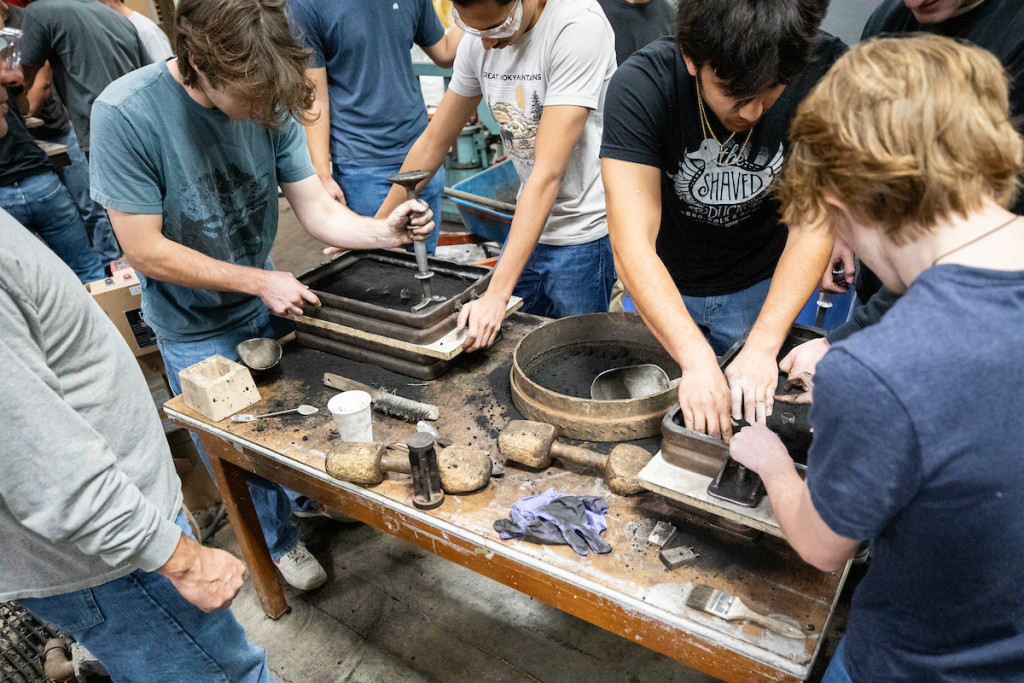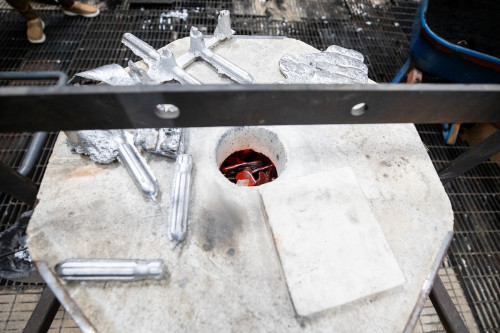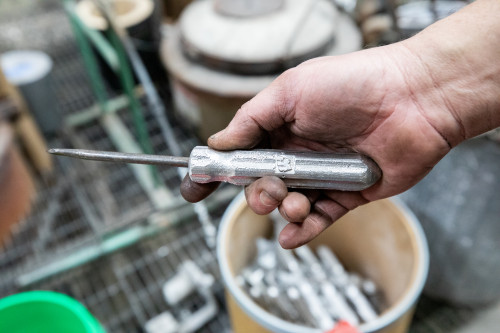Art and Engineering forge partnership for practical learning in Art Department foundry

Students compact sand around a model to create the mold cavity for a screwdriver handle. Photo by Sarah Maughan/UW-Madison
Mechanical engineering students gained practical experience casting screwdriver handles this fall in the Art Department’s foundry in a collaboration between the two departments.
For one week in October, the foundry was the classroom for ME 311 — Manufacturing: Metals and Automation, where more than 200 students worked on creating the handles they had designed.
In this course students learn processes for manufacturing metal parts, including casting. The curriculum focuses on designing parts to make them easier to manufacture, with an eye toward increasing productivity.
Mike DeCicco, teaching faculty in the Department of Mechanical Engineering and the course’s lab coordinator, said it’s important for aspiring engineers — even those who don’t plan to work in a production environment — to learn the process of casting.
“Many products are initially cast,” he said. “It’s really a fundamental skill.”
Understanding fundamental manufacturing processes such as casting can help students design better products, he said.
Frank Pfefferkorn, a professor in mechanical engineering and the course’s lecture instructor, agreed.
“Students gain a better understanding of a manufacturing process that is used to produce almost every metal part at some point in its manufacturing life cycle,” he said. “This exposure will help more students decide if they are interested in pursuing a career at one of the 115 metal casting facilities in Wisconsin or the 1,750 foundries in the United States.”

An electric kiln preheats aluminum blocks to remove moisture, before they are superheated to become molten. Later, the molten metal is poured into the molds. Photo by Sarah Maughan/UW-Madison
Students said the foundry experience was fun and enlightening.
“I personally love the hands-on side of engineering, so all of the ME 311 labs are fun for me,” said Aubrey Olson, a student in the course. “But this one was one of my favorites, because the process of making the mold and seeing the part we made in the same lab was really satisfying.”
The exercise illustrates the overlap between engineering and art, she said. “It reminds me that I can be creative as an engineer as well.”

A finished screwdriver handle cast in the Art Department foundry. Photo by Sarah Maughan/UW-Madison
The collaboration didn’t stop with ME 311. The Art Department’s foundry also hosted 16 students from ME 601 — Advanced Metal Casting on Friday afternoons throughout the fall semester. These students cast Wisconsin mugs, frying pans, and individual designs using aluminum.
In the spring, students interested in working with other metals can enroll in Art 414 — Art Foundry, which also includes projects using bronze.
Leslie Smith III, Art Department chair, expressed enthusiasm for the partnership’s potential to foster interdisciplinary collaboration. He suggested the possibility of cross-listing courses between the departments.
“Right now, we’re just in the trial-and-error mode of figuring out what works, what doesn’t work, and how we might be able to advance this collaboration in terms of working out a united space that fits the needs of both departments,” he said.
Smith added: “We want to create a space where artists and engineers can cohabitate and make students aware of ways they can advance their knowledge in the space through a different lens.”
Tags: arts, engineering




